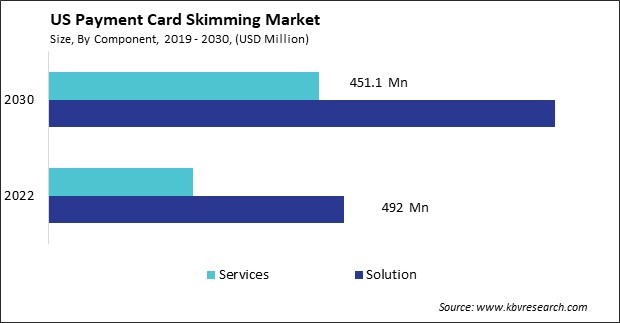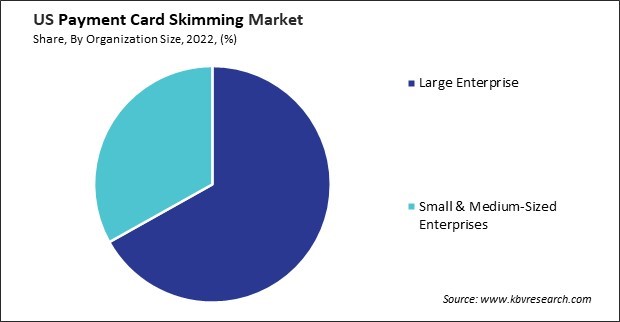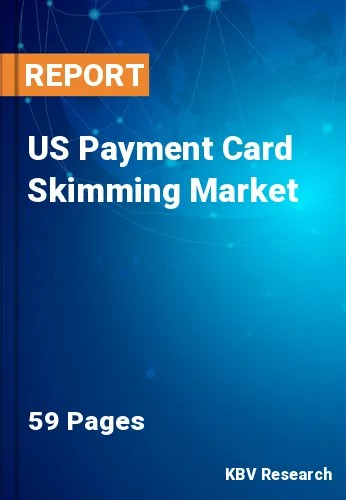The US Payment Card Skimming Market size is expected to reach $1.3 Billion by 2030, rising at a market growth of 7.5% CAGR during the forecast period.
The payment card skimming market in the U.S. has been a significant concern for consumers and businesses. The rise of payment card skimming has been fueled by advancements in technology, making it easier for criminals to produce smaller, more discreet devices that are difficult to detect. Additionally, the widespread adoption of contactless payment methods has led to new vulnerabilities as criminals adapt their tactics to exploit weaknesses in these systems. As a result, consumers and businesses must remain vigilant and take proactive measures to protect themselves against skimming attacks.

One key driver behind the prevalence of payment card skimming market in the U.S. is the widespread adoption of outdated payment infrastructure. While many countries have transitioned to more secure chip-based payment systems, the U.S. has needed to embrace this technology fully. As a result, magnetic stripe cards, which are more vulnerable to skimming attacks, remain prevalent in the American industry.
Businesses that rely on payment card transactions in the U.S. are vulnerable to skimming attacks, as a single breach result in significant financial losses and damage to reputation. Many U.S. companies invest in advanced security measures, such as tamper-evident seals and encryption technology, to protect their payment terminals and mitigate this risk. Additionally, regular inspections and employee training help identify and prevent skimming attempts before they escalate.
However, COVID-19 has further exacerbated the threat of payment card skimming in the U.S. The pandemic has accelerated the adoption of online and contactless payment methods as Americans seek to minimize physical contact and adhere to social distancing guidelines. While these payment methods offer convenience and safety, they also present new opportunities for cybercriminals to exploit vulnerabilities in digital infrastructure. As a result, businesses must remain vigilant and adapt their security protocols to address emerging threats in the evolving landscape of payment fraud.
The prevalence of cashless transactions in the United States has steadily increased over the past decade. Cashless transactions, facilitated by credit and debit cards, mobile payment apps, and online payment platforms, have become the norm for many Americans. The ease of use, speed, and security features of these methods have led to a decline in cash usage. According to a Federal Reserve study, card payments surpassed cash payments in 2016, and the trend has only accelerated. However, the shift towards cashless transactions has also provided opportunities for criminals involved in payment card skimming.
One reason for the increasing prevalence of skimming in cashless transactions is the widespread adoption of EMV (Europay, Mastercard, and Visa) chip technology in payment cards. EMV chips provide enhanced security for in-person transactions by generating a unique code for each transaction, making it difficult for fraudsters to clone cards. As a result, criminals have shifted their focus towards capturing card data during card-not-present transactions, such as online purchases or transactions where the card is swiped rather than inserted into a chip reader.
Additionally, the proliferation of mobile payment apps and digital wallets has created new opportunities for skimming attacks. While these platforms offer added convenience and security features, they also introduce new risks, as criminals develop malware and phishing techniques to steal login credentials and payment card information from unsuspecting users. According to the FBI's Internet Crime Complaint Center (IC3), in 2022, the increase in cyber incidents was primarily driven by phishing schemes in the U.S., which accounted for 300,497 of the complaints. Hence, while the rise of cashless transactions has brought convenience and security benefits, it has also spurred increased efforts by criminals to exploit vulnerabilities in payment systems, necessitating ongoing vigilance and innovation in security measures.
The payment card skimming market in the United States has witnessed a concerning surge in innovation within skimming technology. One prominent trend in skimming technology is the miniaturization of skimming devices. Historically, skimmers were bulky and conspicuous, making them easier for vigilant U.S. consumers and law enforcement to detect. In recent years, advancements have enabled the development of smaller, more discreet skimming devices that can be easily concealed on ATMs, gas pumps, or other point-of-sale terminals. These miniature devices capture payment card data without arousing suspicion, allowing criminals to carry out their schemes undetected for extended periods.
Additionally, there has been a notable shift towards wireless and Bluetooth-enabled skimming technology. Traditional skimmers require physical access to retrieve stolen data manually. However, wireless skimmers eliminate this constraint by transmitting captured data remotely to the perpetrator, often via Bluetooth or cellular networks. This wireless capability enhances the stealthiness of skimming operations and enables criminals to deploy and monitor multiple skimmers simultaneously, amplifying the scale and impact of their illicit activities.
Moreover, advancements in data encryption and spoofing techniques have made it increasingly challenging for U.S. consumers and businesses to identify fraudulent transactions. Furthermore, some skimmers are equipped with technology capable of spoofing legitimate payment terminals, tricking consumers into unwittingly providing their card information to malicious actors. Thus, the proliferation of miniaturized, wireless, and sophisticated skimming technology presents a formidable challenge in combating payment card fraud in the United States.

The payment card skimming market in the U.S. is a concerning facet of cybersecurity and financial fraud. One notable company in the payment card skimming market is SISA Information Security. Based in the U.S., SISA specializes in cybersecurity solutions tailored for the payment card industry. The company offers various services, including vulnerability assessment, penetration testing, and compliance management, to help businesses secure their payment card environments and mitigate the risk of skimming attacks. SISA's expertise in payment card security makes it a trusted partner for organizations seeking to enhance their defenses against fraud.
Another prominent player in the payment card skimming market is FICO (Fair Isaac Corporation). FICO is a leading provider of analytics software and solutions used by banks, retailers, and other businesses to make data-driven decisions. In the realm of payment card security, FICO offers products such as the FICO Falcon Platform, which uses advanced analytics and machine learning algorithms to detect and prevent fraudulent transactions, including those resulting from card skimming. Organizations proactively identify and respond to potential skimming threats by leveraging FICO's technology in real time.
3DSecure is also a significant player in the payment card skimming market. This company specializes in authentication solutions designed to enhance the security of online payment transactions. Implementing multi-factor authentication protocols, such as 3D Secure 2.0 and 3DSecure, helps prevent unauthorized access to cardholder data and reduces the risk of fraudulent transactions, including those initiated by stolen card information obtained through skimming devices. With the rise of e-commerce and online payment fraud, solutions like those offered by 3DSecure play a crucial role in safeguarding consumers and businesses against financial losses.
Additionally, companies like PCI Pal provide solutions for securing payment card data in contact centers and other customer service environments. PCI Pal's suite of products helps organizations comply with Payment Card Industry Data Security Standard (PCI DSS) requirements while safeguarding sensitive cardholder information from theft or unauthorized access. By encrypting card data, implementing secure payment channels, and maintaining strict access controls, PCI Pal helps mitigate the risk of card skimming attacks and ensure compliance with industry regulations.
Furthermore, companies like Verifone and Ingenico Group are major players in the payment terminal industry, providing secure point-of-sale devices with advanced security features to protect against skimming and other payment fraud. These companies collaborate with financial institutions, retailers, and other stakeholders to develop and deploy secure payment solutions prioritizing customer trust and data integrity.
By Component
By Organization Size
By Deployment Type
By Application
Our team of dedicated experts can provide you with attractive expansion opportunities for your business.

